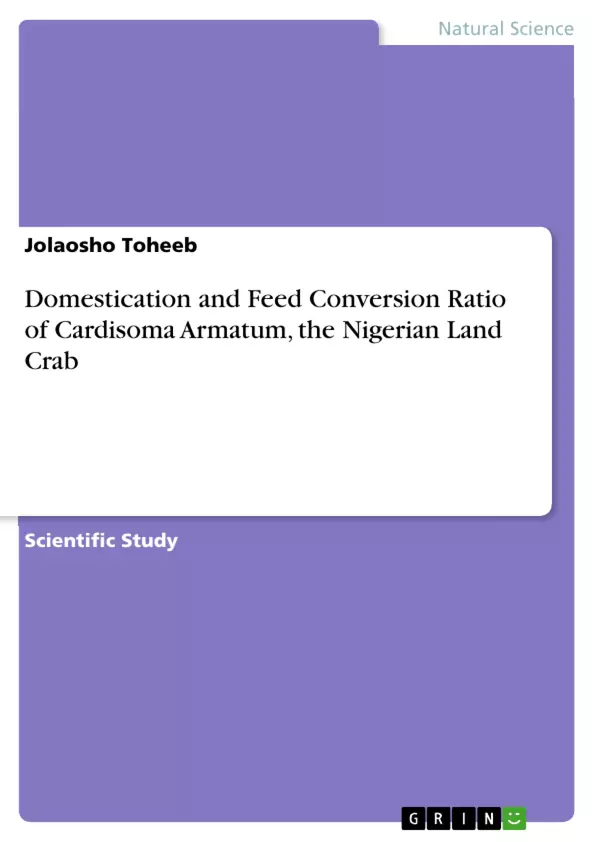The objective of this study is to evaluate the domestication and the growth performance of the land crab (Cardisoma Armatum) cultured in a rectangular concrete unit.
Crabs are part of the basic components of the ecosystem and they are consumed as food in many countries. Over 100 species of crabs are known worldwide with nine species common in West African countries especially Nigeria.
Crabs are decapods crustaceans which have a very short tail and are covered with a thick shell, or exoskeleton and are armed with a single pair of claws. There are over 6,793 species of crab spread across the oceans, fresh water, and even on land. Among the species are the land crab, the big fisted swim crab (callinectes amnicola), and (callinectes latmanus). These 3 species are edible ones.Crabs mostly occur at the mouth of estuaries and along the course of many main rivers. Crabs which are the basic components of the ecosystem are the most advanced members of the phylum Arthropoda.
The freshwater crabs of Nigeria are true crabs which can be distinguished from false crabs by not having 5 pairs of the pereiopods totally or partly concealed beneath the carapace, the antennae were always placed between the inner margin of orbit and fused Pterygostomial region with endotome. True crabs belong to the Suborder Brachyura of order Decapoda under Class Crustacea. It shows the greatest size range of all arthropods such as observed in lobsters, prawns, crayfishes, shrimps, hermit crab and true crabs.
Table of Contents
- CHAPTER ONE.
- INTRODUCTION
- 1.1 BACKGROUND OF THE STUDY.
- 1.2 OBJECTIVE.
- CHAPTER TWO.
- LITERATURE REVIEW
- 2.1 DESCRIPTION
- 2.2 LIFE HISTORY AND POPULATION BIOLOGY
- 2.3 CONDITIONS REQUIRED FOR CRAB CULTURE INVOLVED THE FOLLOWING
- 2.4 MUSA SPECIE (BANANA)
- 2.5 WATER TEMPARATURE
- 2.6 PHYSICAL TOLERANCE
- 2.7 BEHAVIOUR CHARACTERS.
- 2.8 REPRODUCTION.
- 2.9 HABITAT DISTRIBUTION.
- 2.10 LOCOMOTION.....
- 2.11 SALINITY.
- 2.12 CATCHING METHOD
- 2.13 STOCK CONTROL NETTING
- 2.14 HARVEST TECHNIQUES.
- 2.15 POST-HARVEST
- 2.16 MUSA SPP. (BANANA)
- 2.17 COMPOSITION OF MUSA SPECIE FOLIAGE (BANANA LEAF).
- CHAPTER THREE
- MATERIALS AND METHODS
- 3.1 Experimental site...
- 3.2 Sample Size and Technique.
- 3.3 Experimental animals and Design
- 3.4 Experimental diet.
- 3.5 Growth Parameter Matrix.
- 3.6 Data Analysis
- CHAPTER FOUR..
- RESULTS AND DISCUSSION
- 4.1 Data Presentation and Analysis.........
- 4.2 MORTALITY RECORDS.
- 4.3 DISCUSSION
- CHAPTER FIVE
- CONCLUSION AND RECOMMENDATION
- 5.1 CONCLUSION
- 5.2. RECOMMENDATION
Objectives and Key Themes
This study aims to explore the biology, ecology, and aquaculture potential of the land crab, Cardisoma armatum, a species that is both economically and ecologically important in West Africa. The research focuses on various aspects of the crab's life cycle, including habitat distribution, reproduction, and feeding habits.
- Importance of crabs in ecosystems and as a food source.
- Biological and ecological characteristics of Cardisoma armatum.
- Aquaculture potential and challenges for land crabs.
- Nutritional value and importance of crabs in human diets.
- Conservation and management strategies for crab populations.
Chapter Summaries
- Chapter One: Introduction
This chapter introduces the study, highlighting the importance of crabs in ecosystems and their use as a food source. It provides background information on the species, Cardisoma armatum, and its distribution in West Africa. The chapter also outlines the objectives of the research, focusing on the biology, ecology, and aquaculture potential of this crab.
- Chapter Two: Literature Review
This chapter provides a comprehensive overview of the existing literature on the land crab Cardisoma armatum. It delves into the species' life history, population biology, and the environmental conditions necessary for its successful culture. The chapter also discusses the crab's diet, behavior, reproduction, and distribution.
- Chapter Three: Materials and Methods
This chapter outlines the experimental methodology employed in the study. It describes the experimental site, sample size, techniques, and the design of the study. The chapter also details the experimental diet used for the crabs and the growth parameters measured. Finally, it discusses the methods used for data analysis.
- Chapter Four: Results and Discussion
This chapter presents the findings of the study, including data on crab mortality, growth, and other relevant parameters. It analyzes the results and discusses their implications in relation to the literature review and the objectives of the research.
Keywords
Land crab, Cardisoma armatum, aquaculture, West Africa, ecology, biology, habitat, reproduction, diet, nutrition, conservation, management, ecosystem, food source, crustaceans, decapods, Brachyura, Pleocyemata.
- Quote paper
- Jolaosho Toheeb (Author), 2021, Domestication and Feed Conversion Ratio of Cardisoma Armatum, the Nigerian Land Crab, Munich, GRIN Verlag, https://www.grin.com/document/985062




